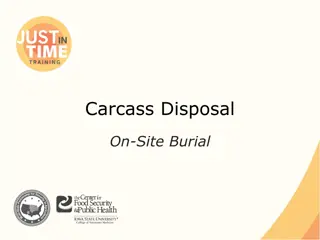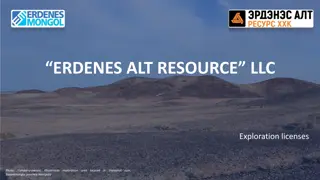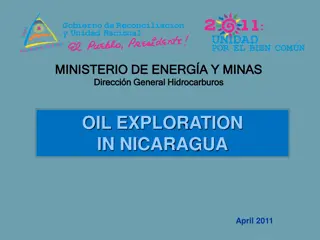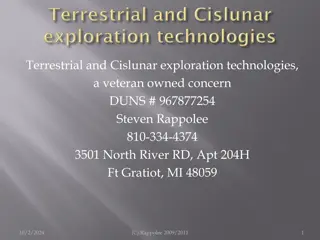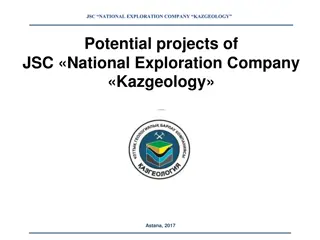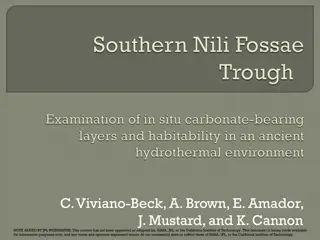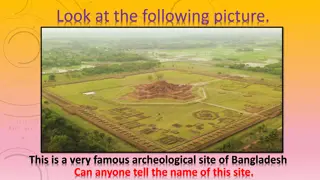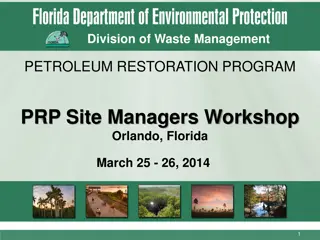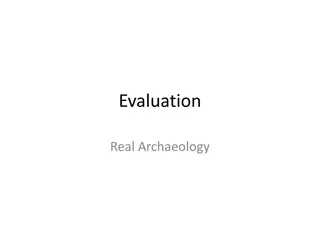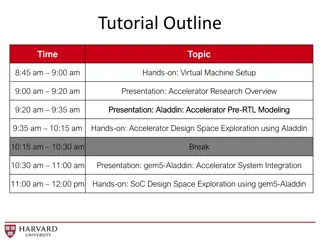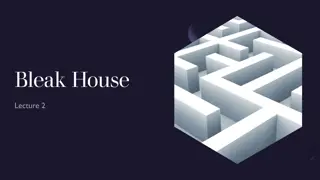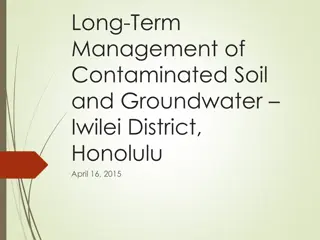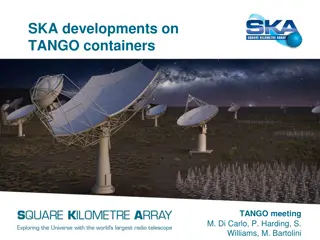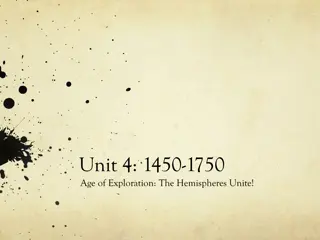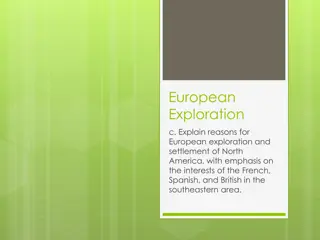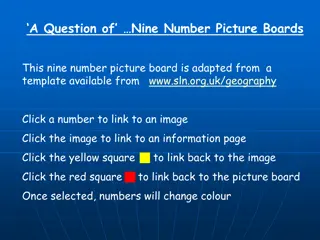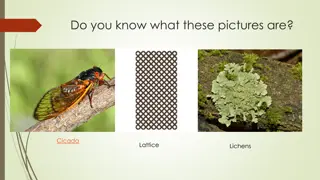Exploration of Site Features through Images
This collection showcases various features found at a specific site, including landscapes, floodplains, terraces, red flags, charcoal layers, and fire-cracked rocks (FCR). The images provide insights into the environment and geological elements present at the site, inviting viewers to explore and analyze these unique aspects.
Download Presentation

Please find below an Image/Link to download the presentation.
The content on the website is provided AS IS for your information and personal use only. It may not be sold, licensed, or shared on other websites without obtaining consent from the author. Download presentation by click this link. If you encounter any issues during the download, it is possible that the publisher has removed the file from their server.
E N D
Presentation Transcript
What Features Were Found at the Site? 1 This work is licensed under a Creative Commons Attribution-NonCommercial-ShareAlike 4.0 International License Creative Commons License
The Landscape of the Site https://upload.wikimedia.org/wikipedia/commons/a/a1/Karl_Bod mer_Travels_in_America_%2872%29.jpg river 2 This work is licensed under a Creative Commons Attribution-NonCommercial-ShareAlike 4.0 International License Creative Commons License
The Landscape of the Site https://upload.wikimedia.org/wikipedia/commons/a/a1/Karl_Bod mer_Travels_in_America_%2872%29.jpg floodplain river 3 This work is licensed under a Creative Commons Attribution-NonCommercial-ShareAlike 4.0 International License Creative Commons License
The Landscape of the Site https://upload.wikimedia.org/wikipedia/commons/a/a1/Karl_Bod mer_Travels_in_America_%2872%29.jpg terrace terrace floodplain river 4 This work is licensed under a Creative Commons Attribution-NonCommercial-ShareAlike 4.0 International License Creative Commons License
These red flags mark features at the site. 5 This work is licensed under a Creative Commons Attribution-NonCommercial-ShareAlike 4.0 International License Creative Commons License
What do you see in this feature? 6 This work is licensed under a Creative Commons Attribution-NonCommercial-ShareAlike 4.0 International License Creative Commons License
Charcoal Layers of Ash Reddened Sand 7 This work is licensed under a Creative Commons Attribution-NonCommercial-ShareAlike 4.0 International License Creative Commons License
Fire-Cracked Rock (FCR) was found in this feature. This is rock that has been exposed to extreme heat, causing it to break. 8 This work is licensed under a Creative Commons Attribution-NonCommercial-ShareAlike 4.0 International License Creative Commons License
Charcoal Layers of Ash Reddened Sand Fire-Cracked Rock What do you think this feature was? 9 This work is licensed under a Creative Commons Attribution-NonCommercial-ShareAlike 4.0 International License Creative Commons License
Charcoal Layers of Ash Reddened Sand Fire-Cracked Rock The feature was a hearth. A hearth is a fire pit. The Anishinabek probably used it to cook or smoke food. Many hearths were found at the M-231 site. 10 This work is licensed under a Creative Commons Attribution-NonCommercial-ShareAlike 4.0 International License Creative Commons License
Investigating a Feature 11 This work is licensed under a Creative Commons Attribution-NonCommercial-ShareAlike 4.0 International License Creative Commons License
Investigating a Feature 12 This work is licensed under a Creative Commons Attribution-NonCommercial-ShareAlike 4.0 International License Creative Commons License
Investigating a Feature 13 This work is licensed under a Creative Commons Attribution-NonCommercial-ShareAlike 4.0 International License Creative Commons License
This feature is a cache pit. There are some 200-300 cache pits at the site. A cache pit is a storage pit. 14 This work is licensed under a Creative Commons Attribution-NonCommercial-ShareAlike 4.0 International License Creative Commons License
cache pit Part of the M-231 Site 15 This work is licensed under a Creative Commons Attribution-NonCommercial-ShareAlike 4.0 International License Creative Commons License
More information about the feature There was a ring of wood at the bottom. WHY? 16 This work is licensed under a Creative Commons Attribution-NonCommercial-ShareAlike 4.0 International License Creative Commons License
More information about the feature There was a ring of wood at the bottom. WHY? Archaeologists think the Anishinabek built a wooden frame around the cache pit. This was so the cache pit would not collapse. 17 This work is licensed under a Creative Commons Attribution-NonCommercial-ShareAlike 4.0 International License Creative Commons License
More information about the feature Bark was found in the bottom. WHY? 18 This work is licensed under a Creative Commons Attribution-NonCommercial-ShareAlike 4.0 International License Creative Commons License
More information about the feature Bark was found in the bottom. WHY? Archaeologists think the Anishinabek lined the cache pit with bark. This helped keep it dry. 19 This work is licensed under a Creative Commons Attribution-NonCommercial-ShareAlike 4.0 International License Creative Commons License
What was being stored? Here are some of the artifacts found in this cache pit: a bone probably from a duck nutshells evidence of Sturgeon evidence of Wild Rice fresh water mussel shells 20 This work is licensed under a Creative Commons Attribution-NonCommercial-ShareAlike 4.0 International License Creative Commons License
What was being stored? Here are some of the artifacts found in other cache pits: raspberry, blackberry and huckleberry seeds remains of white-tailed deer remains of beavers remains of turtles 21 This work is licensed under a Creative Commons Attribution-NonCommercial-ShareAlike 4.0 International License Creative Commons License
One more thing to investigate! The cache pit appears to have two bottom areas. WHY??? 22 This work is licensed under a Creative Commons Attribution-NonCommercial-ShareAlike 4.0 International License Creative Commons License
One more thing to investigate! The cache pit appears to have two bottom areas. WHY??? Archaeologists think the Anishinabek used this pit and then filled it in. Later they used it again. 23 This work is licensed under a Creative Commons Attribution-NonCommercial-ShareAlike 4.0 International License Creative Commons License
3. Cache pits were found at the site. What does this tell us about the Anishinabek? 24 This work is licensed under a Creative Commons Attribution-NonCommercial-ShareAlike 4.0 International License Creative Commons License
3. Cache pits were found at the site. What does this tell us about the Anishinabek? The Anishinabek stored food at the site. The Anishinabek ate plants like Wild Rice and berries. The Anishinabek fished for Sturgeon The Anishinabek hunted for animals like deer and beaver. 25 This work is licensed under a Creative Commons Attribution-NonCommercial-ShareAlike 4.0 International License Creative Commons License
What other features were found at the site? 26 This work is licensed under a Creative Commons Attribution-NonCommercial-ShareAlike 4.0 International License Creative Commons License
cache pits large, shallow roasting pit Part of the M-231 Site 27 This work is licensed under a Creative Commons Attribution-NonCommercial-ShareAlike 4.0 International License Creative Commons License
Archaeologists think large, shallow roasting pits were used to cook food. 28 This work is licensed under a Creative Commons Attribution-NonCommercial-ShareAlike 4.0 International License Creative Commons License
cache pits large, shallow roasting pit processing pit Part of the M-231 Site 29 This work is licensed under a Creative Commons Attribution-NonCommercial-ShareAlike 4.0 International License Creative Commons License
Archaeologists think the processing pits were used to process or cook foods. Remains of deer, beaver and turtle were found in the pits. Many had freshwater mussel shells. The Anishinabek may have been smoking or drying food in these pits. 30 This work is licensed under a Creative Commons Attribution-NonCommercial-ShareAlike 4.0 International License Creative Commons License
cache pits large, shallow roasting pit processing pit shallow basin Part of the M-231 Site 31 This work is licensed under a Creative Commons Attribution-NonCommercial-ShareAlike 4.0 International License Creative Commons License
32 This work is licensed under a Creative Commons Attribution-NonCommercial-ShareAlike 4.0 International License Creative Commons License
cache pits large, shallow roasting pit processing pit shallow basin deep basin Part of the M-231 Site 33 This work is licensed under a Creative Commons Attribution-NonCommercial-ShareAlike 4.0 International License Creative Commons License
34 This work is licensed under a Creative Commons Attribution-NonCommercial-ShareAlike 4.0 International License Creative Commons License
Archaeologists think basins were also used to cook or process foods. They are not sure, however, how they were used. 35 This work is licensed under a Creative Commons Attribution-NonCommercial-ShareAlike 4.0 International License Creative Commons License
Cache Pit Roasting Pit Processing Pit Deep Basin Shallow Basin 4. According to these features, what activities were taking place at this site? 36 This work is licensed under a Creative Commons Attribution-NonCommercial-ShareAlike 4.0 International License Creative Commons License
Archaeologists think the Anishinabek were Hunting animals like deer Fishing for Sturgeon Harvesting Wild Rice Gathering berries and nuts Roasting animals like deer Cooking foods like Sturgeon and freshwater mussels Processing Wild Rice Storing food in cache pits 37 This work is licensed under a Creative Commons Attribution-NonCommercial-ShareAlike 4.0 International License Creative Commons License


